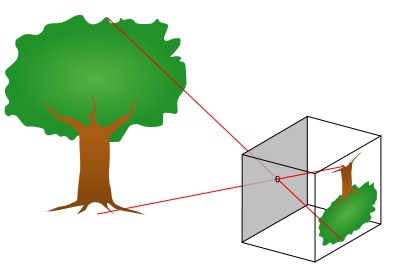Whenever we read about the history of optics or in general electromagnetics we hear two names again and again, these are James Clerk Maxwell and Heinrich Rudolf Hertz. The discoveries of these two gentlemen although very important to development of Physics were very recent (about 150 years old). But the history of optics is much older and the basics of this field were etched in stone about a 1000 years back. One of the people responsible for the early development of this field was Arab mathematician, astronomer, and physicist ibn al-Haytham (c. 965 – c. 1040).
Ibn al-Haytham in his book referred to as the Book of Optics (Kitāb al-Manāẓir) postulated that light travels in form of rays in straight lines and these rays are reflected by objects which makes these objects visible when the rays enter the human eye. Ibn al-Haytham rejected an earlier theory proposed by Ptolemy and widely accepted by the scholars of that time that light rays emanate from the human eye which makes objects visible. Ibn al-Haytham studied the phenomenon of reflection and refraction of rays of light in his laboratory (he studied lenses, experimented with different mirrors: flat, spherical, parabolic, cylindrical, concave and convex). He also used the Camera Obscura in his experiments to show that light rays travel in straight lines. He studied the working of the human eye and was able to make some valuable contributions.

Other than optics ibn al-Haytham made significant contributions to number theory, geometry, astronomy and natural philosophy. Ibn al-Haytham wrote more than 200 works on a wide range of subjects but most of his works are now lost. Only about 96 are known and about 55 have survived to some extent. Those related to the subject of light include The Light of the Moon, The Light of the Stars, The Rainbow and the Halo, Spherical Burning Mirrors, Parabolic Burning Mirrors, The Burning Sphere, The Shape of the Eclipse, The Formation of Shadows, Discourse on Light, as well as his masterpiece, Book of Optics. It was through Latin and Hebrew translations that most of his important work survived.
UNESCO declared 2015 the International Year of Light and ibn al-Haytham was dubbed as the ‘the father of optics’. This was to celebrate ibn Al-Haytham’s achievements in optics, mathematics and astronomy. In honor of him, the Aga Khan University (Pakistan) named its Ophthalmology endowed chair as “The Ibn-e-Haytham Associate Professor and Chief of Ophthalmology”. The crater Alhazen (latin form of his name) on the Moon is named in his honour, as is the asteroid 59239 Alhazen.
PS: An interesting story about ibn al-Haytham is that he proposed to build a dam on the Nile to restrict the flooding it caused but realized soon that it was impossible to solve this problem with the available resources. Ibn al-Haytham feigned madness so as to not upset the ruler (al-Hakim, the Fatimid caliph in Egypt). Legend has it that he was put into confinement in the city of Cairo near Al Azhar University and it is here that he worked on his theories of optics. Al Azhar University still survives today as one of the greatest and oldest university in the world.
Author: Yasir
More than 20 years of experience in various organizations in Pakistan, the USA, and Europe. Worked with the Mobile and Portable Radio Group (MPRG) of Virginia Tech and Qualcomm USA and was one of the first researchers to propose Space Time Block Codes for eight transmit antennas. Have publsihed a book “Recipes for Communication and Signal Processing” through Springer Nature.
One thought on “Ibn al-Haytham – The Father of Optics”